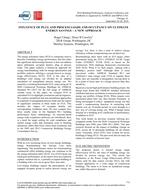Click here to purchase
The energy utilization index (EUI) is commonly used to describe a building’s energy performance. But this index has significant shortcomings because it does not address space utilization, occupant density, plug or process loads. This paper explores a bottom-up approach for energy benchmarking, both for design optimization and portfolio analysis, utilizing a concept known as energy usage effectiveness (EUE). EUE is the ratio of a building’s total energy use divided by an adapted calculation of unregulated process energy use. We started by evaluating benchmark EUE values using all 16 DOE Commercial Prototype Buildings for ASHRAE Standard 90.1-2013 for the full range of ASHRAE climate zones. In this paper, we compare EUE to calculated EUI to highlight correlations and divergences. We explore normalized and non-normalized approaches to treatment of unregulated process loads and the impact of significant variation in these loads on EUE. This includes the impact of occupant density and corresponding ventilation rates. We also compare how these results relate to the Standard 90.1 building performance factor methodology. As outcome-based energy code compliance pathways are introduced, there is a need for target setting for code compliance and stretch energy codes that ultimately scale to building utilization, rather than fixed values most commonly tied to the 2003 and 2012 Commercial Buildings Energy Consumption Survey.
Citation: ASHRAE/IBPSA-USA Bldg Simulation Conf, Sept 2018
Product Details
- Published:
- 2018
- Number of Pages:
- 8
- Units of Measure:
- Dual
- File Size:
- 1 file , 3.8 MB
- Product Code(s):
- D-BSC18-C099
